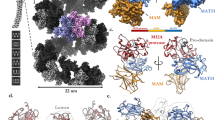Abstract
ASTACIN, a digestive zinc-endopeptidase from the crayfish Astacus astacus L.1,2, is the prototype for the 'astacin family'3–5, which includes mammalian metallo-endopeptidases5 and develop-mentally regulated proteins of man6, fruitfly7, frog8 and sea urchin9,10. Here we report the X-ray crystal structure of astacin, which reveals a deep active-site cleft, with the zinc at its bottom ligated by three histidines, a water molecule and a more remote tyrosine. The third histidine (His 102) forms part of a consensus sequence, shared not only by the members of the astacin family, but also by otherwise sequentially unrelated proteinases, such as vertebrate collagenases11. It may therefore represent the elusive 'third' zinc ligand in these enzymes. The amino terminus of astacin is buried forming an internal salt-bridge with Glu 103, adjacent to His 102. Astacin pro-forms extended at the N terminus, as observed for some 'latent' mammalian astacin homologues, did not exhibit this 'active' conformation, indicating an activation mechanism reminiscent of trypsin-like serine proteinases.
This is a preview of subscription content, access via your institution
Access options
Subscribe to this journal
Receive 51 print issues and online access
$199.00 per year
only $3.90 per issue
Buy this article
- Purchase on Springer Link
- Instant access to full article PDF
Prices may be subject to local taxes which are calculated during checkout
Similar content being viewed by others
References
Stöcker, W., Wolz, R. L., Zwilling, R., Strydom, D. J. & Auld, D. S. Biochemistry 27, 5026–5032 (1988).
Titani, K. et al. Biochemistry 26, 222–226 (1987).
Stöcker, W., Sauer, B. & Zwilling, R. Biol. Chem. Hoppe-Seyler 372, 385–392 (1991).
Barrett, A. J. & Rawlings, D. Biochem. Soc. Trans. 19, 707–715 (1991).
Dumermuth, E. et al. J. biol. Chem. 266, 21381–21385 (1991).
Wozney, J. M. et al. Science 242, 1528–1534 (1988).
Shimell, M. J., Ferguson, E. L., Childs, S. R. & O'Connor, M. B. Cell 67, 469–481 (1991).
Sato, S. M. & Sargent, T. D. Dev. Biol. 137, 135–141 (1990).
Reynolds, S. D., Angerer, L. M., Palis, J., Nasir, A. & Angerer, R. C. Development 114, 769–786 (1992).
Lepage, T., Ghiglione, C. & Cache, C. Development 114, 147–164 (1992).
Stöcker, W., Ng, M. & Auld, D. S. Biochemistry 29, 10418–10425 (1990).
Matthews, B. W., Jansonius, J. N., Colman, P. M., Schoenborn, B. P. & Dupourque, D. Nature new Biol. 238, 37–41 (1972).
Pauptit, R. A. et al. J. molec. Biol. 199, 525–537 (1988).
Thayer, M. M., Flaherty, K. M. & McKay, D. B. J. biol. Chem. 266, 2864–2871 (1991).
Lipscomb, W. N. et al. Brookhaven Symp. Biol. 21, 24–90 (1968).
Matthews, B. W. Accts chem. Res. 21, 333–340 (1988).
Vallee, B. L. & Auld, D. S. Biochemistry 29, 5647–5659 (1990).
Kounnas, M. Z., Wolz, R. L., Gorbea, C. M. & Bond, J. S. J. biol. Chem. 266, 17530–17537 (1991).
Huber, R. & Bode, W. Accts chem. Res. 11, 114–122 (1978).
Springman, E. B., Angleton, E. L., Birkedal-Hansen, H. & Van Wart, H. E. Proc. natn. Acad. Sci. U.S.A. 87, 364–368 (1990).
Goldberg, G. J. et al. J. biol. Chem. 261, 6600–6605 (1986).
Shannon, J. D., Baramova, E. N., Bjarnason, J. B. & Fox, J. W. J. biol. Chem. 264, 11575–11583 (1989).
Whitham, S. E. et al. Biochem. J. 240, 913–916 (1986).
Titani, K., Hermodson, M. A., Ericsson, L. H., Walsh, K. A. & Neurath, H. Nature new Biol. 238, 35–37 (1972).
Turk, D. thesis, Technische Universität, München (1992).
Priestle, J. P. J. appl. Crystallogr. 21, 572–576 (1988).
Messerschmidt, A. & Pflugrath, J. W. J. appl. Crystallogr. 20, 306–315 (1987).
Brünger, A. T. X-PLOR Manual version 2.1 (Yale University, New Haven, 1990).
Jones, T. A. Acta Crystallogr. A34, 931–935 (1978).
Bernstein, F. C. et al. J. molec. Biol. 122, 535–542 (1977).
Author information
Authors and Affiliations
Rights and permissions
About this article
Cite this article
Bode, W., Gomis-Rüth, F., Huber, R. et al. Structure of astacin and implications for activation of astacins and zinc-ligation of collagenases. Nature 358, 164–167 (1992). https://doi.org/10.1038/358164a0
Received:
Accepted:
Issue Date:
DOI: https://doi.org/10.1038/358164a0
This article is cited by
-
Conformational remodeling enhances activity of lanthipeptide zinc-metallopeptidases
Nature Chemical Biology (2022)
-
The Wnt-specific astacin proteinase HAS-7 restricts head organizer formation in Hydra
BMC Biology (2021)
-
The C-terminal region of human plasma fetuin-B is dispensable for the raised-elephant-trunk mechanism of inhibition of astacin metallopeptidases
Scientific Reports (2019)
-
Structure, function and development of the digestive system in malacostracan crustaceans and adaptation to different lifestyles
Cell and Tissue Research (2019)
-
Crystal structures of the human adiponectin receptors
Nature (2015)
Comments
By submitting a comment you agree to abide by our Terms and Community Guidelines. If you find something abusive or that does not comply with our terms or guidelines please flag it as inappropriate.



